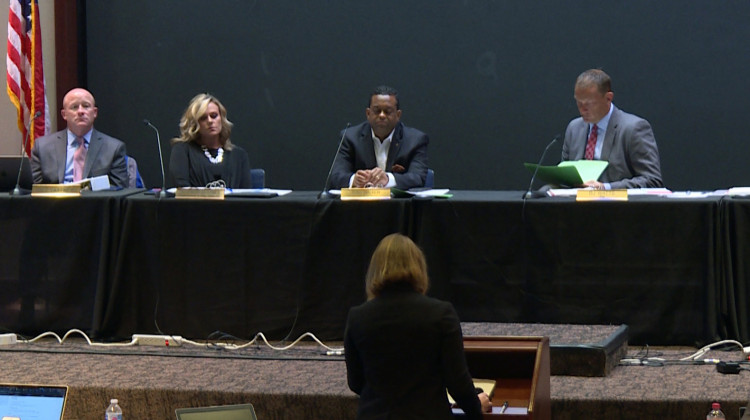
Indiana State Board of Education members ask questions of state director of assessment Charity Flores after seeing the state's first round of ILEARN scores.
Jeanie Lindsay/IPB NewsResults for the state’s new ILEARN test are now public, and reveal just how much lower achievement rates on the test look compared to previous iterations of the state’s standardized exam. According to state data, less than half of all students reached proficiency in English Language Arts (ELA) and math, with proficiency rates of 47.9 and 47.8 percent respectively.
On the 2018 ISTEP, 50.7 percent of students passed the ELA and math portions of the test. The 2019 ILEARN results show only 37.1 percent of students passed both portions.
State Superintendent of Public Instruction Jennifer McCormick has renewed pressure for lawmakers to overhaul the state’s school accountability system ahead of the publication of the scores. Last week, Gov. Eric Holcomb and several other policymakers sent out public statements saying they want to “hold schools harmless” for the dip in achievement, as concerns mounted about their likely negative impact.
Even so, McCormick says the state saw worse declines in the 2015 ISTEP+ rollout – particularly in math – and educators have been working to bring scores back up ever since.
“So we are still feeling the impact of the last performance declines, that we were digging ourselves out of that, and we were moving in the right direction,” McCormick says.
The Indiana Department of Education’s director of assessment Charity Flores says the new test was developed completely separate from the ISTEP, and that educators involved in building the test highlighted key areas to evaluate whether or not students are on a path to being “college and career ready.”
“As a result, some priorities of the content to change to more rigorous standards. We also are assessing content on ILEARN that had previously not been assessed fully,” she says.
Examples of those include listening standards, research tasks in science, computer science standards, and algebraic functions.
Flores also points out the new test is part of efforts to create a “system of assessments” in Indiana, aimed at providing better data.
“So we had an opportunity as ILEARN was being built to leverage some of our national best practices to ensure coherence, efficiency, and also the national perspective that our students in Indiana must be college and career ready,” Flores says.
The State Board of Education also approved a resolution at its meeting, saying it won’t assign school letter grades on the state’s accountability system until lawmakers have taken action to not penalize schools or teachers for the drop in test scores.
Ahead of the vote, members peppered Flores with questions about the new test, scores, and how they should be looked at.
Board member Dave Freitas cautioned the comparisons of test scores year to year, pointing out each group is a different cohort than the last. He says improving how on track students are to being college and career ready is a problem more complicated than just providing schools and students with remediation help.
“It’s the state of the state of education in the state of Indiana,” he says. “And if fewer than 50 percent of the students are not meeting basic proficiency and are not on track, on that trend, it goes beyond resources I think.”
The results also illustrate the achievement gap between white students and their black, Hispanic, and multiracial peers in Indianapolis public schools and across the state.
That has prompted some education leaders to say the results should not be disregarded completely, as they show a need to improve learning outcomes for all students, including minority students and those at the lowest-performing schools.
"The scores are what they are. Schools and school districts need to start locally addressing their situations reflected by this," says board member Tony Walker. "I think this is the best test we've had as a state assessment – ever. And it's not a problem with this test probably. So we need to figure out what the problem is and fix it."
Less than 15 percent of black students and less than a quarter of Hispanic students in grades 3 through 8 passed both math and English portions of the ILEARN. White students passed both test parts at 43.3 percent. Among Asian students, about 57 percent passed the test.
As part of Indiana's plan to adhere to the federal Every Student Succeeds Act, McCormick pledged to close the student achievement gap in English and mathematics for special education students, students of color and other unique populations by 50 percent by 2023.
WFYI's Eric Weddle contributed to this story.
This story has been updated.
Contact Jeanie at jlindsa@iu.edu or follow her on Twitter at @jeanjeanielindz.
 DONATE
DONATE









 Support WFYI. We can't do it without you.
Support WFYI. We can't do it without you.